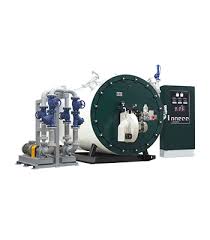
ডিসে. . 11, 2024 19:11 Back to list
steam boiler components and functions
Steam Boiler Components and Functions
Steam boilers are essential devices in various industrial processes, heating applications, and power generation. They convert water into steam by applying heat through combustion or other methods. Understanding the different components of a steam boiler and their functions is critical for maintaining efficiency and ensuring safe operations. This article provides an overview of the main components of steam boilers and their respective functions.
1. Boiler Shell
The boiler shell is the outer casing that houses the entire assembly of the boiler. It is designed to withstand the pressure generated within the boiler and ensure the safe containment of steam and water. The shell is typically constructed from thick steel to provide durability and strength, and its design can vary depending on the type of boiler.
2. Furnace
The furnace is where the fuel is burned to generate heat. Its design depends on the type of fuel being used, whether it be natural gas, coal, oil, or even biomass. The furnace is equipped with burners that atomize the fuel, ensuring optimal combustion for maximum heat generation. The heat produced in the furnace is transferred to water within the boiler, converting it to steam.
3. Heat Exchanger
The heat exchanger is a crucial component that facilitates the transfer of heat from the furnace to the water. It allows the thermal energy generated in the furnace to be absorbed by the water in the boiler. Efficient heat exchange is vital for the overall efficiency of the boiler. Various designs, such as fire-tube and water-tube heat exchangers, can be employed depending on the boiler design and application.
4. Water Feed System
The water feed system is responsible for supplying water to the boiler. It typically includes a feedwater pump that moves water from a storage tank into the boiler. The water must be treated and conditioned to remove impurities, preventing scale buildup and corrosion within the boiler. Maintaining proper water levels is essential for safety and efficiency, as too little water can lead to overheating and damage to the boiler.
steam boiler components and functions

5. Steam Drum
In a steam boiler, the steam drum is a large cylindrical vessel that serves as a separator for steam and water. As water is heated and converted into steam, the steam rises to the top of the steam drum, where it can be drawn off for use in various applications. The steam drum also plays a critical role in maintaining consistent steam quality and pressure.
6. Safety Valves
Safety valves are essential for ensuring the safe operation of a steam boiler. They are designed to release excess pressure that builds up within the boiler to prevent explosions or other hazardous failures. These valves automatically open when the pressure exceeds a predetermined limit, allowing steam to escape and ensuring that the pressure remains within safe operating limits.
7. Control Systems
Modern steam boilers are equipped with sophisticated control systems that monitor and regulate various parameters, such as temperature, pressure, and water levels. These systems use sensors and control valves to maintain optimal operating conditions, enhancing efficiency and safety. The automation allows for more precise management of the boiler's performance.
8. Flue Gas Stack
The flue gas stack is an important component that directs exhaust gases generated during combustion out of the boiler and into the atmosphere. It is designed to safely vent harmful emissions while maximizing the efficiency of the combustion process. Heat recovery systems may also be incorporated to utilize exhaust heat for preheating feedwater or other applications.
Conclusion
In summary, understanding the components and functions of steam boilers is crucial for anyone involved in industrial operations, power generation, or facility management. Each component plays a significant role in the overall efficiency, safety, and effectiveness of steam generation. Proper maintenance and monitoring of these components are essential to ensure reliable operation and to extend the lifespan of the boiler. By recognizing the importance of these elements, operators can enhance productivity while minimizing operational risks associated with steam boilers.
-
Best Steam Boiler Design PDF Free Design Calculation & Diagram Downloads
NewsJun.10,2025
-
Hot Boiler Water Heater Efficient Heating Solutions for Home & Commercial Use
NewsJun.10,2025
-
Steam Boiler Safety Devices High-Quality Protection Valves
NewsJun.10,2025
-
Ultimate Steam Boiler Checklist for Safety & Efficiency
NewsJun.10,2025
-
Optimal Hot Water Boiler Temperature Setting Guide
NewsJun.10,2025
-
Effective Hot Water Boiler Chemical Treatment Protect & Maintain
NewsJun.09,2025
Related PRODUCTS






















